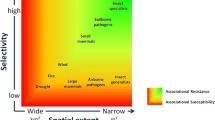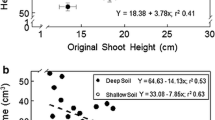Abstract
A comparative study of the regeneration ecology ofthree lesser-known leguminous timber species wasconducted in the seasonally dry forests of SantaCruz, Bolivia to determine species regenerationstrategies and make silvicultural recommendationsfor these species. The study included arepresentative from each subfamily of Leguminosae:Anadenanthera colubrina (Vell. Conc.) Benth.(Mimosaceae), Copaifera chodatiana Kunth.(Caesalpinaceae), and Centrolobium microchaeteC. Martius (Fabaceae). After production in themid-late dry season, seeds of all species sufferedhigh (>30%) rates of predation. For seedssurviving predation, Anadenanthera germinatedwithin three days after the first rains and a highgermination capacity (82%), but most seedlings diedfrom inadequate light or during subsequent periodsof drought. Copaifera germinated more slowlybut had high germination capacity (85%). Centrolobium had very low germination capacity(4%) and germinative energy. Most successfulregeneration of Centrolobium occurred viasprouting from damaged roots on or near loggingroads where it had a density of 261 root sprouts/ha.Anadenanthera regenerated best from seedin areas with soil disturbance or burning. Theregeneration of these species will likely increaseunder more intensive logging and/or post-harvestcompetition control treatments in logging gaps. Themore shade-tolerant Copaifera is most suitedto the current regime of light selective logging,but all three species are likely to be responsive topost-harvest competition control treatments. Impacts of controlled and natural fire were mixed,but generally seedling regeneration and growth wereeither not significantly affected or were increasedby fire.
Similar content being viewed by others
References
Augspurger, C.K. 1986. Morphology and dispersal potential of wind-dispersed diaspores of tropical trees. Am. J. Bot. 73: 353-363.
Barbosa, D.C.A. 1991. Crescimiento de Anadenanthera macrocarpa (Benth.) Brenan (Leguminosae-Mimosoideae). Phyton 52: 51-62.
Bazzaz, F.A. 1990. Regeneration of tropical forests: Physiological responses of pioneer and secondary species, pp. 91-118. In: Gó mez-Pompa, A., Whitmore, T.C. and Hadley, M. (Eds) Rain Forest Regeneration and Management. UNESCO and Parthenon Publishing, Paris.
Chazon, R.L. 1998. Tropical forests-log 'em or leave 'em. Science 281: 1295-1296.
Connell, J. 1971. On the role of natural enemies in preventing competitive exclusion in some marine animals and rain forest trees, pp. 298-310. In: den Boer, P.J. and Gradwell, G.R. (Eds) Dynamics of Populations. Centre for Agricultural Publishing and Documentation, Wageningen.
Dickinson, M.B., Whigham, D.F. and Hermann, S.M. In press. Tree regeneration, felling and natural treefall disturbance in a semideciduous tropical forest in Mexico. For. Ecol. Manage.
Fox, J.E.D. 1976. Constraints on the natural regeneration of tropical moist forest. For. Ecol. Manage. 1: 37-65.
Fredericksen, T.S. 1998. Limitations of low-intensity selective and selection logging for sustainable tropical forestry. Comm. For. Rev. 77: 262-266.
Fredericksen, T.S. and Justiniano, M.J. 1998. Ecología y silvicultura de especies menos conocidas: Sirari-Copaifera chodatiana. Proyecto BOLFOR, Santa Cruz, Bolivia.
Fredericksen, T.S. and Kennard, D. 1999. Guía par la realizació n de quemas controladas, Technical Document. Proyecto BOLFOR, Santa Cruz, Bolivia.
Gullison, R.E., Panfil, S.N., Strouse, J.J. and Hubbell, S.P., 1996. Ecology and management of mahogany (Swietenia macrophylla King) in the Chimanes Forest, Beni, Bolivia. Bot. J. Linn. Soc. 122: 9-34.
Hall, J.B. 1996. Seedling ecology and tropical forestry. In: Swaine, M.D. (Ed) Ecology of Tropical Forest Tree Seedlings. Parthenon Publishing, Paris.
Janzen, D. 1970. Herbivores and the number of tree species in tropical forests. Am. Nat. 104: 501-528.
Janzen, D. 1971. Seed predation by animals. Ann. Rev. Ecol. Sys. 2: 465-492.
Janzen, D.H. and Vázquez-Yanes, C. 1990. Aspects of tropical seed ecology of relevance to management of tropical forested wildlands, pp. 137-157. In: Gó mez-Pompa, A., Whitmore, T.C. and Hadley, M. (Eds) Rain Forest Regeneration and Management. UNESCO and Parthenon Publishing, Paris.
Justiniano, M.J. and Fredericksen, T.S. 1998a. Ecología y silvicultura de especies menos conocidas:Tarara-Centrolobium microchaete. Proyecto BOLFOR, Santa Cruz, Bolivia.
Justiniano, M.J. and Fredericksen, T.S. 1998b. Ecología y silvicultura de especies menos conocidas:Curupaú -Anadenanthera colubrina. Proyecto BOLFOR, Santa Cruz, Bolivia.
Kozlowski, T.T. 1949. Light and water in relation to growth and competition of Piedmont forest tree species. Ecol. Monogr. 19: 207-231.
Ledig, F.T. 1992. Human impacts on genetic diversity in forest ecosystems. Oikos 63: 87-108.
Lowe, R.G. 1995. How can ecology contribute to the silviculture of tropical high forest and its regeneration Comm. For. Rev. 74: 162-163.
Mostacedo, B., Fredericksen, T.S. and Toledo, M. 1998. Respuestas de las plantas a la intensidad de aprovechamiento en un bosque semi-deciduo pluviestacional de la regió n de Lomerío, Santa Cruz, Bolivia. Boletín de Sociedad Botánica Boliviana 2: 75-88.
Murphy, P.G. and Lugo, A.E. 1986. Ecology of tropical dry forest. Ann. Rev. Ecol. Syst. 17: 67-88.
Nascimiento, M.T. and Proctor, J. 1996. Seed attack by beetles and leaf-cutter ants on Peltogyne gracilipes Ducke (Caesalpinaceae) on Maracá Island, Brazilian Amazon. J. Trop. Ecol. 12: 723-727.
Navarro, G. 1995. Clasificació n de la vegetació n de Lomerío en el Departamento de Santa Cruz, Bolivia, Technical Document 10. Proyecto BOLFOR, Santa Cruz, Bolivia.
Parker, T.A., Gentry, A.H., Foster, R.B., Emmons, L.H. and Remsen, J.V. 1993. The Lowland Dry Forests of Santa Cruz, Bolivia: A Global Conservation Priority. Conservation International, Rapid Assessment Program, RAP Working Papers, No. 4, Washington, DC.
Pinard, M.A., Putz, F.E., Rumiz, D., Guzmán, R. and Jardim, A. 1999. Ecological characterization of tree species for guiding forest management decisions in seasonally dry forests in Lomerío, Bolivia. For. Ecol. Manage. 113: 201-213.
Redhead, J.F. and Hall, J.B. 1992. Tropical Forestry. Longman Group. London, UK. 118 pp.
Snook, L.K. 1996. Catastrophic disturbance, logging and the ecology of mahogany (Swietenia macrophylla King): Grounds for listing a major tropical timber species on CITES. Bot. J. Linn. Soc. 122: 35-46.
Veizaga, R.E. 1997. Influencia de depredores sobre semillas y plantines sobre algunas especies forestales de interes comercial en claros con y sin tratamientos silviculturales. Undergraduate Thesis, Universidad Autonomo Gabriel Rene Moreno, Santa Cruz, Bolivia.
Viscarra, S. and Lara, R. 1992. Maderas de Bolivia. Camara Nacional de Bolivia, Santa Cruz, Bolivia, 291 pp.
Author information
Authors and Affiliations
Rights and permissions
About this article
Cite this article
Fredericksen, T., Justiniano, M., Mostacedo, B. et al. Comparative regeneration ecology of three leguminous timber species in a Bolivian tropical dry forest. New Forests 20, 45–64 (2000). https://doi.org/10.1023/A:1006735819449
Issue Date:
DOI: https://doi.org/10.1023/A:1006735819449




